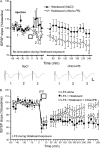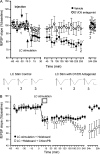Dopamine D1/D5 receptors contribute to de novo hippocampal LTD mediated by novel spatial exploration or locus coeruleus activity
- PMID: 22038910
- PMCID: PMC3412443
- DOI: 10.1093/cercor/bhr297
Dopamine D1/D5 receptors contribute to de novo hippocampal LTD mediated by novel spatial exploration or locus coeruleus activity
Abstract
The neurons of the locus coeruleus (LC) fire in response to novelty, and LC activation coupled with hippocampal afferent stimulation leads to long-term depression (LTD). The encoding of novel spatial information also involves activation of dopamine D1/D5 receptors. It is unclear if, or how, the noradrenergic and dopaminergic systems interact mechanistically in processing novelty. Novel spatial exploration when coupled with Schaffer collateral (SC) test-pulse stimulation results in short-term depression at SC-CA1 synapses, which is not observed in the absence of afferent stimulation. However, activation of D1/D5 receptors under these conditions without concomitant afferent stimulation enables slow-onset depression. LTD (>24 h) is facilitated when novel exploration occurs concurrently with low-frequency stimulation of CA1. Effects are not improved by a D1/D5 agonist. Facilitation of LTD (>4 h) by coupling LC stimulation with CA1 test-pulse stimulation was blocked by a D1/D5 antagonist, however, as was habituation to the holeboard environment. Novel spatial learning during LC stimulation did not enhance LTD further, whereas D1/D5 agonist treatment enabled LTD to persist for over 24 h. These data suggest that the regulation of hippocampal LTD by the LC is supported by D1/D5 receptors and that their contribution to information storage becomes important when the thresholds for persistent LTD have not been reached.
Figures





Similar articles
-
Frequency-dependency of the involvement of dopamine D1/D5 and beta-adrenergic receptors in hippocampal LTD triggered by locus coeruleus stimulation.Hippocampus. 2022 Jun;32(6):449-465. doi: 10.1002/hipo.23419. Epub 2022 Apr 28. Hippocampus. 2022. PMID: 35478421
-
Antagonism of D1/D5 receptors prevents long-term depression (LTD) and learning-facilitated LTD at the perforant path-dentate gyrus synapse in freely behaving rats.Hippocampus. 2014 Dec;24(12):1615-22. doi: 10.1002/hipo.22340. Epub 2014 Aug 27. Hippocampus. 2014. PMID: 25112177
-
Dopamine D1/D5 receptors gate the acquisition of novel information through hippocampal long-term potentiation and long-term depression.J Neurosci. 2006 Jul 19;26(29):7723-9. doi: 10.1523/JNEUROSCI.1454-06.2006. J Neurosci. 2006. PMID: 16855100 Free PMC article.
-
Dopamine D1/D5 receptors mediate informational saliency that promotes persistent hippocampal long-term plasticity.Cereb Cortex. 2014 Apr;24(4):845-58. doi: 10.1093/cercor/bhs362. Epub 2012 Nov 25. Cereb Cortex. 2014. PMID: 23183712 Free PMC article. Review.
-
Heteromerization of dopamine D2 receptors with dopamine D1 or D5 receptors generates intracellular calcium signaling by different mechanisms.Curr Opin Pharmacol. 2010 Feb;10(1):93-9. doi: 10.1016/j.coph.2009.09.011. Epub 2009 Nov 10. Curr Opin Pharmacol. 2010. PMID: 19897420 Free PMC article. Review.
Cited by
-
Is non-invasive neuromodulation a viable technique to improve neuroplasticity in individuals with acquired brain injury? A review.Front Hum Neurosci. 2024 Sep 4;18:1341707. doi: 10.3389/fnhum.2024.1341707. eCollection 2024. Front Hum Neurosci. 2024. PMID: 39296918 Free PMC article. Review.
-
Repetition suppression in the medial temporal lobe and midbrain is altered by event overlap.Hippocampus. 2016 Nov;26(11):1464-1477. doi: 10.1002/hipo.22622. Epub 2016 Aug 12. Hippocampus. 2016. PMID: 27479864 Free PMC article.
-
Corticotropin-releasing factor induces functional and structural synaptic remodelling in acute stress.Transl Psychiatry. 2021 Jul 7;11(1):378. doi: 10.1038/s41398-021-01497-2. Transl Psychiatry. 2021. PMID: 34234103 Free PMC article.
-
Novelty and Dopaminergic Modulation of Memory Persistence: A Tale of Two Systems.Trends Neurosci. 2019 Feb;42(2):102-114. doi: 10.1016/j.tins.2018.10.002. Epub 2018 Nov 16. Trends Neurosci. 2019. PMID: 30455050 Free PMC article. Review.
-
Altered neuronal excitability underlies impaired hippocampal function in an animal model of psychosis.Front Behav Neurosci. 2015 May 20;9:117. doi: 10.3389/fnbeh.2015.00117. eCollection 2015. Front Behav Neurosci. 2015. PMID: 26042007 Free PMC article.
References
-
- Albensi BC, Oliver DR, Toupin J, Odero G. Electrical stimulation protocols for hippocampal synaptic plasticity and neuronal hyper-excitability: are they effective or relevant? Exp Neurol. 2007;204:1–13. - PubMed
-
- Andersen PH, Jansen JA. Dopamine receptor agonists: selectivity and dopamine D1 receptor efficacy. Eur J Pharmacol. 1990;188:335–347. - PubMed
-
- Beckstead RM. Association of dopamine D1 and D2 receptors with specific cellular elements in the basal ganglia of the cat: the uneven topography of dopamine receptors in the striatum is determined by intrinsic striatal cells, not nigrostriatal axons. Neuroscience. 1988;27:851–863. - PubMed
-
- Besheer J, Short KR, Bevins RA. Dopaminergic and cholinergic antagonism in a novel-object detection task with rats. Behav Brain Res. 2001;126:211–217. - PubMed
Publication types
MeSH terms
Substances
LinkOut - more resources
Full Text Sources
Research Materials
Miscellaneous

